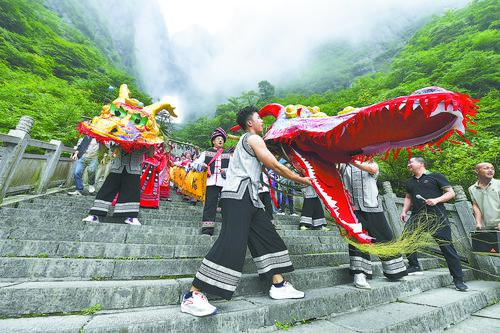Tech Lights Up Cultural and Natural Heritage Day
By?YU?Haoyuan

Artists perform a dragon dance at the Tianmen Mountain in Zhangjiajie, Hunan province. (PHOTO: XINHUA)
Under the aegis of the National Cultural Heritage Administration, China's cultural institutions organized over 3,000 events and more than 7,000 related activities to celebrate Cultural and Natural Heritage Day and showcase the nation's rich cultural heritage as well as science and technology prowess.
This year, the theme was "Protecting Cultural Heritage, Passing on Civilization."
Each region's activities displayed regional characteristics, emphasizing education, prioritizing public welfare, innovating communication methods, and promoting the shared use of cultural relics.
China has stepped up excavation, preservation and showcasing its historical and cultural significance. Museums across the country are keeping pace with the times with enhanced technological capabilities, innovation and creativity.
Hunan province in central China used a fusion of "culture + technology" to hold activities related to local intangible cultural heritage. A variety of intangible cultural heritage digital creative products gave visitors a technology-infused feast of intangible cultural heritage. For example, through augmented reality technology, visitors interacted with adorable "Xiang embroidery" pandas, and viewed artifacts like Baoqing bamboo carvings, a renowned traditional handicraft, in 360 degrees, and 3D-printed ceramic vases.
In Sichuan province in southwest China, the fourth "national cultural relics census" is currently underway. Researchers are using a newly developed census system to collect sub-meter resolution satellite remote sensing images, integrating GPS and big data from the internet, and combining aerial photography via drones for the most accurate coordinates and spatial positions of cultural relics. At the Guanyin Temple in the province's Xinjin city, infrared imaging technology is being used so that researchers can see the carved words on the roofs of century-old wooden houses more clearly, while high-definition digital technology restores the details in photos. Thanks to this high-definition imaging, the famous "Twelve Enlightenment Buddha" mural can be viewed in remarkable detail, down to the three layers of transparent gauze sheathing the body of Guanyin, the deity of compassion.
On June 8, the Shaanxi History Museum hosted a special exhibition using advanced mixed reality (MR) technology in their front courtyard. The exhibition displayed nine exquisite cultural relics from the museum's collection, including bronze artifacts from the Shang dynasty (about 1600 BC to 1046 BC) and Zhou dynasty (1046 BC to about 256 BC), and gold and silver vessels from the Tang Dynasty (618 to 906 AD) to promote knowledge and awareness of cultural relics. Brought out of their showcases, these carefully selected artifacts created an immersive viewing experience through sound, light, shadow and other elements of MR technology. Visitors wearing intelligent MR glasses could adjust the viewing angles and even interact with the artifacts through gestures.
Since 2006 China began to celebrate Cultural and Natural Heritage Day on the second Saturday of June every year. Currently, China boasts 57 world heritage sites, ranking second globally. Among these, there are 14 natural heritage sites and four cultural heritage sites, covering a total area of 70,600 square kilometers.






